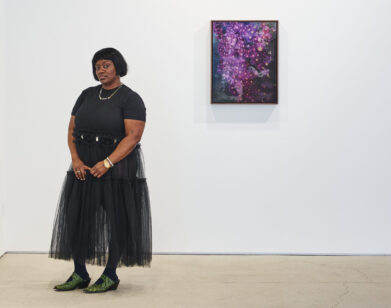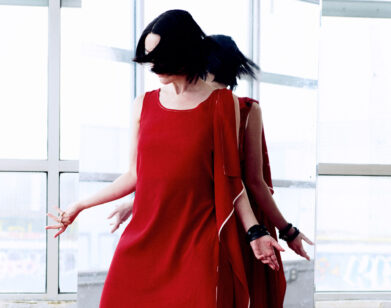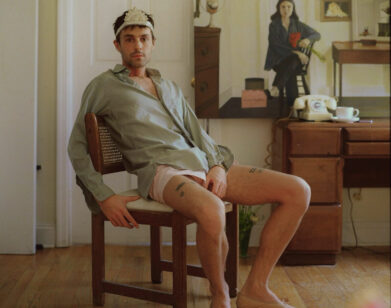It’s A Little About Kennedy Yanko
PHOTOS, ABOVE, COURTESY OF SHANE LAVANCHER
Judith Malina’s 2012 play History of the World stands firmly as the definitive high-water mark for downtown Manhattan’s now-defunct Living Theatre. The play’s themes were timely (see: Occupy) and its cast was as strong as any in the theater’s long history (including Soraya Broukhim, Kyle Ryan, Homa Hynes, and Brent Wellington Barker III). The standout in the troupe, however, was Kennedy Yanko, who deftly inhabited the roles of both French Neoclassicist painter Jacques Louis-David and Venus, the goddess of love.
Yanko continues to embody these figures—and transcend them. Her artwork will be featured in a group show produced by Russell Simmons and Bombay Sapphire currently on view at Rush Gallery in Chelsea. She is also the subject of a Damon Dash-produced art and fitness documentary coming out later this year, which highlights her physical transformation at the hands of her “life-changing” trainer, the impossibly jacked Kali O’Mard.
We spoke with Kennedy Yanko about her upcoming solo show “Alchemy in Silent Spaces,” which opens at Idiosyncrasy in Brooklyn next week. The show continues to build on her fascination with Daoism, acrylics, and the physics behind performance, reaching a new and satisfying level of complexity and maturity.
KURT MCVEY: I first met you while you were a resident performer at The Living Theatre. How did your time there shape you as an artist?
KENNEDY YANKO: On a foundational level, it gave me a community in New York. I came to Judith [Malina, Living Theatre co-founder] after a year at The San Francisco Art Institute with a proposal for an installation piece. She opened her doors to me as a visual artist, and I ultimately ended up living and performing there. It taught me how to navigate the city, how to navigate through relationships, how to seek out mentors and how to ultimately become one. Judith educated me about the storied history of New York. Al Pacino and Yoko Ono paid our rent. You’re hanging out with the guys from Pink Floyd, having tea with Anne Waldman, who started Naropa with Ginsberg and Kerouac. To hang out with these people, who are ultimately down to earth, it really helps to put things in perspective. On a psychological level, it challenged me—living with 12 actors in a basement on the Lower East Side and having to go to these uncomfortable places within myself to perform and interact every day. It definitely shaped me as a physical and sensory artist.
MCVEY: Did you read that Penny Arcade article? They referenced Judith.
YANKO: Yes! It was great. I love Penny.
MCVEY: The Living Theatre is no more, and I would never say Judith Malina bowed out of the scene or retired….
YANKO: You better not. [laughs]
MCVEY: She’s not as hands-on as Penny, but she’s still in it. I think what we’re seeing now, though, is the transition from that generation’s prominence as downtown performers, artists, and tastemakers being handed over to a new generation.
YANKO: It’s definitely easy to talk about Warhol and Pollock all those guys and talk about how cool downtown used to be, how cool Montauk used to be, but I have to stress to my friends: Hey, don’t forget, we’re doing it. If you’re here, and you’re passionate, you’re doing it. That being said, we wouldn’t be here without them.
MCVEY: I don’t know if you’re familiar with the diatribes Patti Smith, Madonna, and most recently David Byrne went on in regards to how New York isn’t necessarily interested in harboring young artists anymore, but as someone who is here, right now, and so clearly doing it, what is your rebuttal to that? What are the personal challenges facing you as an artist and how do you surmount them?
YANKO: I think so much of it is about perspective. Everything that you do is a choice; and listen, the New York that we know is probably very, very different from the New York that they experienced, rent-wise or whatever, but as a person, as a human, New York is a place of cultivation, no matter what. You want to be an actor? You come here and you learn it and when you want to make your money, go out to L.A. Here, you build a strong backbone. You can’t help but absorb the overwhelming amount of information this place has to offer. And yeah, it’s hard, but again, it’s a choice. You can go make money. You don’t have to starve. I’m here for a reason, and if I didn’t have a passion, I wouldn’t be here.
MCVEY: What is your passion?
YANKO: I want to set myself up in a situation where I can paint anywhere in the world. Where I can do whatever I want and live off my work. And it’s the conversation. You don’t get this anywhere else. Everyone here, on every corner, through every doorway, is passionate. If your not passionate, you’re here for the wrong reasons.
MCVEY: Let’s talk about your solo show at Idiosyncrasy. I was just speaking with Mary-Evelyn Pritchard, who secured the space. Can you, on behalf of Mary, explain how Idiosyncrasy came into being?
YANKO: Absolutely. Mary is a great hostess and the most graceful person I have ever met. She’s so sweet and so kind. She saved every single penny she ever made or was given for Christmas and put roughly a hundred thousand dollars into the space. When she first moved in, random drug dealers would come through, stepping over used condoms and syringes, talking about how they used to have crazy raves there. In a totally DIY fashion, Mary turned it into a gallery, a multi-faceted studio space, as well as a home and a sanctuary for blossoming artists such as myself.
MCVEY: You said your work is a physical process. There’s an element of performance as well, but you also have this fascinating end product—these flowing, undulating, abstract, psychedelic, three-dimensional, acrylic-on-rubber wall sculptures. Why does this current style or process speak to you?
YANKO: I think your words are so sweet, because this particular series really is about the work speaking to me. The show is called “Alchemy in Silent Spaces,” and it’s been a five-year process for me now, allowing the paint to do what it wants to do. In 2009, I did a collection called “Wu-Wei,” which means “to allow” in Chinese, and I was getting these really miraculous fractal-like details, but less than 24 hours after that show I knew I had to take it farther. So I took the concept off canvas and started making paint skins, but they were too delicate. So for my 2012 show “Permutation,” all 30 pieces were done on rubber, which gave each one a skeleton and a backbone. When I talk about the work itself, it always sounds like I’m talking about the human body—the skin—it’s all very visceral to me. When they’re on the wall, they breathe. They have real presence.
MCVEY: Would you use the word “abstract” to describe your work?
YANKO: Sure. I’m starting to call myself a sensory artist and a visual artist. It makes more sense to me. It’s conceptual, but also experiential.
MCVEY: When you create artwork that isn’t so much about delivering a recognizable image, how important is it for the artist to have a compelling persona to function as the tangible image behind the work? When people talk about Pollock’s work, they often lean on the man himself.
YANKO: I think it actually leaves more space for us. It’s about the conversation and about being available to listen to what the paint is saying. At the same time, when someone looks at my work, it’s, What are you feeling? It’s not, What are you seeing? It’s not about me. Well, it’s a little about me. [laughs]
MCVEY: Well, the night of the gallery opening it’s about you. [laughs]
YANKO: The rest of the month it can be about you, but at the opening reception, that’s all me, baby. That’s my night! [laughs]
MCVEY: You’ve gone through a pretty dramatic physical change over the last three or four months.
YANKO: You can say it. I’m a beast. [laughs]
MCVEY: Do you ever feel the implications of your sex, your gender, or your body image coming into play in not only the art itself, but in the larger art world? Or is this a complete non-issue for you? Are you just an artist?
YANKO: I know it sounds weird, but I don’t relate as a female artist. I don’t think I told you this, but I legally changed my name in college. When I was growing up, my name was Hanna Elizabeth Kennedy Yanko. I was taking a class in New Genres, and I bring these conceptual pieces into the critique, and they were like, “It looks like a female artist who’s not sure about her race or sexuality.” And I thought, Fuck off; it’s an abstract painting!
MCVEY: You’re answering my earlier question about how people naturally impose the persona of the artist onto the work if there’s no obvious relatable image.
YANKO: I changed my name so that when you looked at it or heard it, you wouldn’t know if I was a man or a woman. Whatever I am, though, it’s something that I’ve taken in stride. I have a beautiful life, but it’s of my own making. My philosophy is to flirt with life.
MCVEY: Do you think that maybe a few generations from now, we as a society might naturally detach ourselves from these indicators that preface our larger identity as artists?
YANKO: You can’t, because, what are we? I’m a half-black, female artist. How can I not be aware of the fact that I’m a sex object? We are our experiences, our words, and the things we’re trying to get through to people who can’t see it. That’s what we’re doing.
MCVEY: I just see this prevailing thing in our culture right now where as artists; we embrace these identifiers only if they work to our advantage. In this country, especially in the media, we love to have our cake and eat it too.
YANKO: That’s true, but it’s also what makes America so fascinating. Artists are always trying to find themselves and when they do, they usually go out of their way to shed that same image. It’s complicated, but without that dynamic, without that contrast, what are we talking about?
KENNEDY YANKO’S SOLO SHOW, “ALCHEMY IN SILENT SPACES,” WILL HAVE AN OPENING RECEPTION ON THURSDAY, NOVEMBER 14, FROM 8 PM TO MIDNIGHT AT IDIOSYNCRASY GALLERY IN BROOKLYN.







